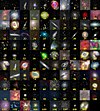NGC 891
| Galaxie NGC 891 | |
|---|---|
 | |
| Aufnahme mit einem 60-cm-Teleskop | |
| AladinLite | |
| Sternbild | Andromeda |
| Position Äquinoktium: J2000.0, Epoche: J2000.0 | |
| Rektaszension | 02h 22m 33,41s [1] |
| Deklination | +42° 20′ 57″ [1] |
| Erscheinungsbild | |
| Morphologischer Typ | SA(s)b? / sp / HII[1] |
| Helligkeit (visuell) | 10,1 mag[2] |
| Helligkeit (B-Band) | 10,9 mag[2] |
| Winkelausdehnung | 13,5′ × 2,5′[1] |
| Positionswinkel | 22°[2] |
| Flächenhelligkeit | 13,1 mag/arcmin²[2] |
| Physikalische Daten | |
| Zugehörigkeit | NGC-1023-Gruppe[1] |
| Rotverschiebung | 0.001761 ± 0.000013[1] |
| Radialgeschwindigkeit | (528 ± 4) km/s[1] |
| Hubbledistanz H0 = 73 km/(s • Mpc) | (30 ± 2) · 106 Lj (9,05 ± 0,64) Mpc [1] |
| Masse | ca. 3,2 · 1011 M☉ |
| Durchmesser | 125.000 Lj[3] |
| Geschichte | |
| Entdeckung | Wilhelm Herschel |
| Entdeckungsdatum | 6. Oktober 1784 |
| Katalogbezeichnungen | |
| NGC 891 • UGC 1831 • PGC 9031 • CGCG 538-052 • MCG +07-05-046 • IRAS 02195+4209 • 2MASX J02223290+4220539 • GC 527 • H V 19 • h 218 • LDCE 160 NED006 | |
NGC 891 ist eine Spiralgalaxie mit ausgedehnten Sternentstehungsgebieten vom Hubble-Typ Sb im Sternbild Andromeda am Nordsternhimmel. Die Galaxie ist rund 30 Millionen Lichtjahre von der Milchstraße entfernt und gehört zur NGC-1023-Gruppe. Mit einem Durchmesser von 150.000 Lichtjahren ist NGC 891 die dominierende Galaxie dieser Gruppe und gleichzeitig eine der größten bekannten Spiralgalaxien.[4]
Das Objekt steht in Wechselwirkung mit der etwa 250.000 Lj. von ihr entfernten Zwerggalaxie UGC 1807.
Im selben Himmelsareal befinden sich weiterhin u. a. die Galaxien NGC 898, NGC 906, NGC 909, NGC 911.
Die Typ-II-Supernova SN 1986J wurde hier beobachtet.[5]
Aufgrund einer Verwechslung wurde die Entdeckung von NGC 891 lange Zeit Caroline Lucretia Herschel zugeschrieben, tatsächlich wurde die Galaxie aber am 6. Oktober 1784 von Wilhelm Herschel entdeckt.[6] Aufnahmen der Galaxie mittels des Hubble-Weltraumteleskops zeigen ihre Details.
- Nördlicher Teil
- Details des Zentrums
Namentliche Erwähnung fand diese Galaxie in einer Ansage des Bordcomputers in John Carpenters Film Dark Star – Finsterer Stern ("Wenn die Dämmerung auf NGC 891 niedersinkt").
Literatur
- König, Michael & Binnewies, Stefan (2019): Bildatlas der Galaxien: Die Astrophysik hinter den Astrofotografien, Stuttgart: Kosmos, S. 54
Weblinks
- SIMBAD Astronomical Database
- J. L. Tonry, A. Dressler, J. P. Blakeslee, E. A. Ajhar, A. B. Fletcher, G. A. Luppino, M. R. Metzger, C. B. Moore: The SBF Survey of Galaxy Distances. IV. SBF Magnitudes, Colors, and Distances, Astrophysical Journal 546 (2): S. 681–693 (2001), bibcode:2001ApJ...546..681T
- astronews.com: Bild des Tages 14. Mai 2012
- Spektrum.de: Sammlung von Amateuraufnahmen
- Edge-on beauty (engl.)
- CDS Portal
Einzelnachweise
Auf dieser Seite verwendete Medien
Autor/Urheber: NASA Hubble, Lizenz: CC BY 2.0
If we could travel across space and time to see our own galaxy from the outside looking in, it would probably look a lot like Caldwell 23. This spiral galaxy, also cataloged as NGC 891, is about 35 million light-years away from Earth in the constellation Andromeda. Sir Patrick Moore, creator of the Caldwell catalog, once said the full galaxy looks like “two fried eggs clapped back to back.” In this Hubble image, taken in visible and infrared light using the Advanced Camera for Surveys, the “yolk” portion of the galaxy is out of the picture beyond the lower left corner. A few foreground stars from the Milky Way shine brightly, while more-distant galaxies can be seen in the lower right corner of the image.
Astronomers used Hubble’s observations of Caldwell 23 to learn more about the structure and evolution of spiral galaxies. One of their findings helped identify the source of Caldwell 23’s galactic “halo.” The halo surrounds the galaxy and primarily contains old stars, some of which are grouped together in large, sphere-shaped collections called globular clusters. The source of this halo material has been unclear, since theoretically it could either originate in the galaxy or be gravitationally pulled in from the area surrounding the galaxy. Scientists using Hubble found that Caldwell 23’s halo is similar in composition to other material in the galaxy, which suggests that the halo material was expelled from within the galaxy.
This Hubble image shows wispy tendrils of dust and gas branching off from the plane of the galaxy into the halo. Astronomers believe these structures formed as material was ejected outward by supernovae or intense star formation activity. When massive stars light up at birth or explode at death, they produce powerful winds that can blow dust and gas over hundreds of light-years of space.
Caldwell 23 was discovered by astronomer William Herschel in October 1784. The galaxy has a magnitude of 10, so use a telescope to see it, away from any sources of light pollution. Under ideal conditions you can make out the galaxy’s central dark lane. Autumn night skies in the Northern Hemisphere will provide the best view. In the Southern Hemisphere, look for Caldwell 23 in the springtime.
For more information about Hubble’s observations of Caldwell 23, see:
www.spacetelescope.org/images/potw1220a/
hubblesite.org/contents/news-releases/1999/news-1999-10.html
Credit: ESA/Hubble & NASA; Acknowledgement: Nick Rose
For Hubble's Caldwell catalog site and information on how to find these objects in the night sky, visit:
www.nasa.gov/content/goddard/hubble-s-caldwell-catalogAutor/Urheber: Roberto Mura, Lizenz: CC BY-SA 3.0
Caldwell Catalogue objects.
Autor/Urheber: Credit Line and Copyright Adam Block/Mount Lemmon SkyCenter/University of Arizona, Lizenz: CC BY-SA 3.0 us
NGC 891
Picture Details:
Optics 24-inch RC Optical Systems Telescope Camera SBIG STL11000 CCD Camera Filters Custom Scientific Dates October 9th, 2008 Location Mount Lemmon SkyCenter Exposure LRGB = 180:60:60:60 minutes Acquisition TheSky (Software Bisque), Maxim DL/CCD (Cyanogen) Processing CCDStack (CCDWare), Mira (MiraMetrics), Maxim DL (Cyanogen), Photoshop CS3 (Adobe)Credit Line and Copyright Adam Block/Mount Lemmon SkyCenter/University of Arizona






